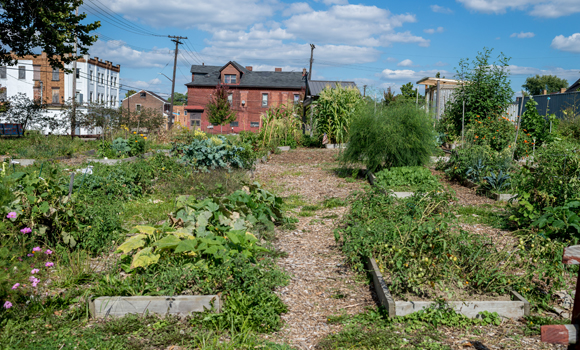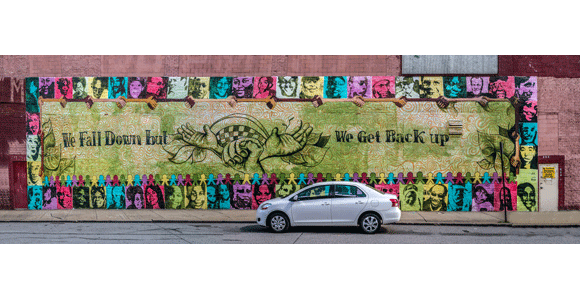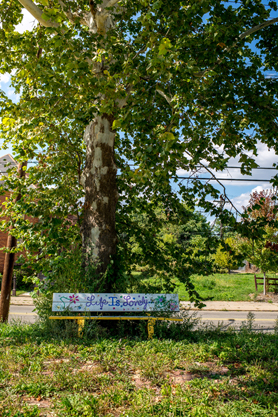Over the past few years, the East End neighborhood of Larimer has seen its fortunes change drastically. After struggling for decades with population flight, housing blight, rising crime rates, geographic boundaries and lack of development investment, the neighborhood is now reaping the benefits of growing support from the public and private sectors.
But Larimer’s path to revitalization was not an overnight success story. Champions in the local government and nonprofit community are working to aid residents who have been combating Larimer’s issues for nearly a generation, witnessing firsthand how a city neighborhood can be left to drown in forces beyond its control.
A history of decline
Situated next to East Liberty with borders defined by Negley Run Road, Washington Boulevard and the Martin Luther King Jr. East Busway, Larimer was settled in the second half of the 19th century by German immigrants and railroad magnate William Larimer, who built a manor house overlooking East Liberty along what is currently Larimer Avenue. Around the turn of the 20th century, Italian immigrants comprised the largest single ethnic group in the area, and for a time defined Larimer as Pittsburgh’s Little Italy. For the next 50 to 60 years, people moved to the area as new housing was constructed and complimented by a healthy business district along the Larimer Avenue corridor.
Reflecting trends sweeping across all of Pittsburgh, beginning in the '60s, Larimer faced a number of obstacles. A mass exodus of residents led the population to dwindle from a high of 16,000 in 1940 to 1,700 by 2010, contributing to increasing numbers of vacant and abandoned housing. Lack of employment and city services, a blighted business district, extremely low rates of home ownership and violent crime all played their part in Larimer’s continued decline.
By the late 1990s, community groups such as East Liberty Concerned Citizens Corporation, the Lincoln-Larimer Community Development Corporation and the Kingsley Association tried to stop the bleeding. Residents created the Larimer Community Plan to outline the neighborhood’s biggest issues and to provide a vision of the future.
What followed was nearly a decade of false starts, held back by politics, administration changes, lack of community involvement, and the inability to get community partners on the same page regarding what was best for the neighborhood.
“During that time, it was a slow process to get everyone on board,” says Judith K. Ginyard, a long-time neighborhood resident, real estate broker and former head of the Lincoln-Larimer Community Development Corporation who is planning to run for the District 9 City Council seat. “The attention from the local government just wasn’t there. When you have a number of false-hope residents participating in design schemes and planning sessions, and those things never materialize or go anywhere, the community gets very frustrated. People soon realized that if anything was going to happen in the neighborhood, it was going to be according to what the government wanted to have done, as opposed to what the community wanted to have done.”
The Larimer vision
Jackson/Clark Partners is a Pittsburgh-based consulting group that has worked in Larimer for the past seven years on various community-based initiatives. Principal Pat Clark also saw the back and forth of the planning process in the neighborhood and understood that, above all, residents needed to be driving the neighborhood's revitalization.
“There were a lot of people in local leadership roles who didn’t take ownership,” says Clark. “If a community plan didn’t work out, people [who worked for local politicians and urban planning organizations] shrugged and said ‘Our boss is an idiot.' You can’t leave communities to political leaders; you can’t leave communities to experts. People who live in the neighborhood are the ones who have to really step up and take the lead if anything is going to happen. But that doesn’t happen until residents really believe that change is possible.”
In 2008, with new support from the Urban Redevelopment Authority, State Sen. Jim Ferlo and Jackson/Clark Partners, Larimer updated its community plan with more expansive community engagement, defining a clearer process for new development, leading to the organization of the Larimer Consensus Group and a series of action teams comprised of volunteers who tackled neighborhood issues.
This signaled the next stage in the area's evolution: As Pittsburgh’s local government began focusing more resources on assisting Larimer, and local community groups gained more funding to support their constituency. In the years that followed, neighborhood projects like the Larimer Community Garden flourished, East Liberty Development Incorporated worked on a Larimer Vision Plan (in 2010), and businesses like East End Brewery and community development nonprofit GTECH made the neighborhood home.
“The Larimer Consensus Group has been determined to transform Larimer into a green, sustainable community, and our partners have joined in on that mindset,” says Donna Jackson, a 30-year resident of the neighborhood and administrator of the Larimer Consensus Group. “The reality is that everyone has their own idea regarding what Larimer can be, but when you’re revitalizing a neighborhood, you never want to return it to what it was, you want to make it a little bit better.”
Betting on Larimer's future
The momentum continued in the summer of 2014 when Larimer was awarded $30 million in Choice Neighborhood funding from the U.S. Department of Housing and Urban Development. The money is devoted to the construction of 350 mixed-income housing units and mixed-use development that aligns with the desires outlined in the Larimer Community Plan.
It was the biggest bet yet made on a neighborhood that just 10 years earlier wasn’t given a chance as a public investment. Community partners and volunteers, with the aid of Jackson/Clark Partners, rallied to apply for and win a significant piece of funding awarded to only four other cities in America. After almost two decades of planning, there was a tangible piece of progress.
“It was important for us to empower Larimer’s residents during this whole process,” says Jackson. “We are all volunteers, and it was up to us to let people in this neighborhood know they can cause change.”
But the work isn’t done. As the Choice Neighborhood money arrives — and is most likely leveraged for increased private investment — the next few years will be extremely important for the future of Larimer. Increased levels of engagement from the entire community, including newcomers and lifelong residents, are essential to informing the direction of development.
Still, it feels like a new chapter has begun.
“The people I have the most compassion for are the people that have been living in Larimer during this whole 20-year process, being a part of the deterioration of the community,” says Ginyard. “There are people that have been stuck in Larimer for two or three generations, and those are the people that need the benefits this type of money can provide.”



